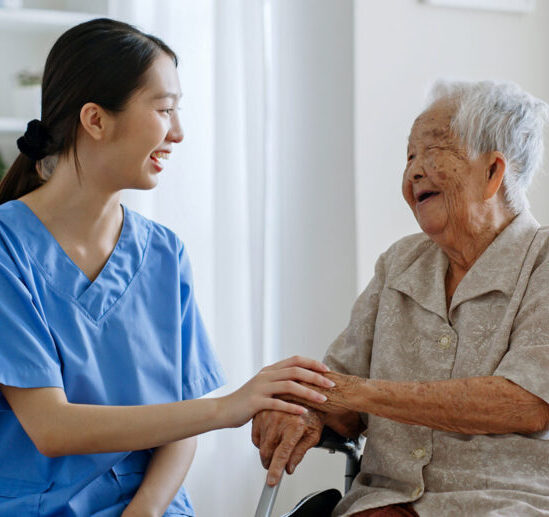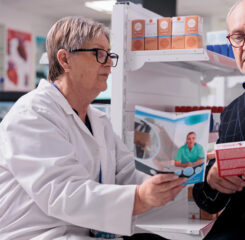Abbott BinaxNow Webinar for Assisted Living Facilities
The Office of the Assistant Secretary for Health, the CDC and Abbott jointly presented a webinar targeted to assisted living facilities receiving the new Abbott BinaxNOW test kits on September 18. Moderator Dr. Tammy Beckham, Lead for Testing and Diagnostics Working Group at HHS, indicated that HHS has purchased 150 million BinaxNOW tests. These tests are simpler and less expensive than other antigen tests and have Sensitivity of 97.1% and Specificity exceeding 98%. A recording of the webinar will be posted within a few days. Here is a brief summary of highlights.
BinaxNOW tests are intended for use in individuals whose healthcare providers suspect COVID-19 and the tests should be run within the first seven days of symptom onset. Negative results in symptomatic individuals should be retested using molecular (PCR) tests. However, they can be used for repeat testing per the FDA’s FAQs on testing for SARS COV-2 and guidance from HHA.
Providers using these tests need to have a CLIA waiver or to partner with a provider that has a CLIA certification or waiver or apply for a waiver themselves. Providers should:
- Notify public health officials of their intent to run these tests
- Report the results
- Ensure appropriate training and interpretation
- Collect performance data and report to FDA/ HHS/ Abbott
- Retain all records
Abbott BinaxNOW tests are rapid lateral flow immunoassay tests administered by a direct nasal swab. Kits include cards, extraction reagents, collection swabs, instructions and procedure cards. Kits must be stored at 2 -30 degrees Celsius. Used kits must be treated as biohazard waste and CDC guidance regarding PPE should be followed.
Abbott presenters explained the internal and external quality control measures and processes to be followed. These protocols should be follow with each new shipment, when training operators and to conform to local, state and federal regulations. They believe that kits will be readily available and HHS will provide kits to AL (and some nursing homes) based on county prevalence rates.
The process is essentially as follows:
- Using only the swabs provided rotate 5 or more times against the nasal wall and then repeat that process with the other nostril
- Samples should be tested immediately after collection
- The extraction reagent is added to the swab as prescribed and the sample swab is inserted into the test card and rotated 3 times, then the card is closed with the swab inside
- Results are read visually and need to be read not earlier than 15 minutes nor later than 30 minutes after the sample is inserted in the card
There are also apps (NAVICA) that are designed to be end-to-end secure COVID-19 testing solutions – one for consumers and one for test administrators and allow results to be transmitted securely to consumers.
Abbott’s training toolkit includes:
- Binax NOW Demo video
- Four topical BinaxNOW training videos
- Support documents and links to a website with FAQs that will be updated regularly
Questions should be directed to Abbott M-F 8am -8pm at 800-257-9525 or ts.scr@abbott.com
Dr. Nimalie Stone from the CDC reviewed CDC resources and guidance for preventing the spread of COVID-19 in assisted living centers. She further explained that the timing of test-taking relative to COVID-19 exposure and symptomatology greatly affects test results. If tests are conducted too early, they are not likely to detect the virus. The virus is most detectable at about the time of symptom onset – 5-7 days after exposure. Other factors influencing test results include:
- Quality of specimen collection
- Proper use of the test platform
- Clinical presentation at the time of testing
- Prevalence in the center and the community
She reviewed a slide entitled “SARS COV-2 testing in response to a case”. Key points were:
- New infections in staff or residents
- Expand diagnostic testing for all staff and residents – prioritize symptomatic and high risk individuals
- Perform testing of all previously negative residents and staff every 3-7 days until there are no positives for 14 days
- Prioritize for known exposure and risk
A brief Q and A session highlighted these points:
- The recording will be linked
- Tests will also be sent to SNFs in counties with high prevalence
- Can use for asymptomatic individuals per guidance for repeat staff testing

Most Recommended
October 15, 2025
 Shutdown Week Three: Impact of Ongoing Closure on Affordable Housing
Shutdown Week Three: Impact of Ongoing Closure on Affordable Housing
October 30, 2025
Fiscal Year (FY) Funding 2026
October 07, 2025
Immigrant Workforce Matching Program Brings Workforce Relief
Recently Added
October 30, 2025
 Shutdown: Older Adults' Access to Energy Assistance Under Threat
Shutdown: Older Adults' Access to Energy Assistance Under Threat
October 29, 2025
Medicare Advantage Takes Center Stage on John Oliver HBO Show
October 29, 2025



